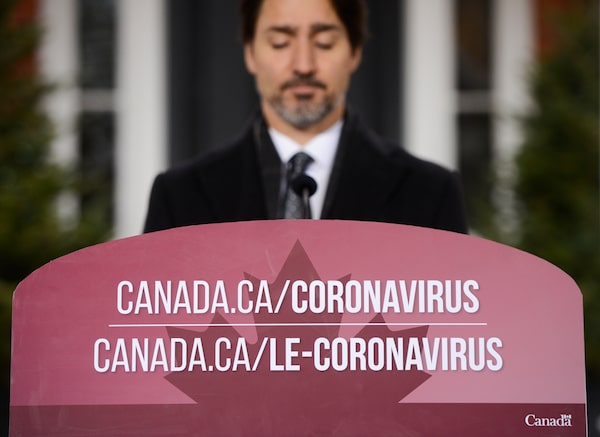
While not wanting to make too big a deal of it, Justin Trudeau, seen here on April 3, 2020, addressed the comparison between Canada and the U.S. earlier this week.Sean Kilpatrick/The Canadian Press
War analogies, with respect to the coronavirus onslaught, are appropriately plentiful these days.
In the United States, the invasion force landed while the big general was caught napping. The commander-in-chief’s defences were initially unprepared, lacking in equipment, unable to repulse the enemy – until it became evident that tens of thousands, maybe 240,000, would fall.
Canadian forces were more prepared. They reacted earlier. The general in Ottawa – it’s easy for him to look good given who is in the Oval Office – didn’t downplay the seriousness of the threat by comparing it to a normal flu bug. The population heeded his warnings and took shelter in greater numbers. The number of deaths, by comparison, has been markedly limited.
Wherever you live and work, chances are your workplace has been affected by the coronavirus pandemic. Many businesses have closed, either voluntarily or under provincial bans on non-essential services, and those closings and layoffs have affected hundreds of thousands of people.
- If you have been laid off, the Canada Emergency Response Benefit will help you stay afloat. And: additional career advice.
- Here’s how to apply for EI and other COVID-19 emergency government income supports
Toronto employment lawyer Daniel Lublin answered frequently asked questions about COVID-19′s impact on the work force. Some questions include:
- If my employer shuts down because of COVID-19, am I entitled to severance?
- If I have COVID-19, am I entitled to my salary while quarantined?
- What types of questions can my employer ask me related to COVID-19?
Though the federal and some provincial governments have introduced income supports for workers that don’t qualify for EI benefits, many businesses have called for larger wage subsidies to prevent layoffs, as well as a broad freeze on payments to government.
Get a second opinion:
- What are the rules around temporarily laying off employees?
- My boss wants me to self-quarantine without pay. Is that legal?
- Is this a bad time to be switching jobs?
Have a question that you’d like answered? Send them to NineToFive@globeandmail.com. You can also check The Globe and Mail’s digest of the latest news about COVID-19′s spread around the world.
Because the pandemic is such an unprecedented event, the legal landscape will be changing quickly. There may be considerations about your personal situation which make the information here inapplicable to you. To obtain advice that relates to your personal circumstances, the best route is to contact an employment lawyer.
While not wanting to make too big a deal of it, Justin Trudeau addressed the comparison earlier this week. “I think I would say we’re not necessarily on the same trajectory,” he said in French. “We were quicker to get the screening done, and I think we have had more success in getting people to self-isolate.”
For his part, Donald Trump is maintaining his reputation for showing no special regard for Canada. His administration reportedly pressed medical manufacturer 3M to stop exporting N95 masks to foreign countries, including Canada, prompting a rebuke from the Prime Minister: “It would be a mistake for both of our countries to limit access to goods and essential personnel."
With per-capita differences taken into account, the number of deaths in the U.S. from COVID-19 was roughly four times that in Canada at this writing. The war is still in its early stages, and much could change. The number of fatalities in Canada has worsened considerably – it is now 166 – in the past few days. Ontario released projections Friday of 3,000 to 15,000 deaths over a one- to two-year period. The U.S. numbers are 100,000 to 240,000 over the next couple of months.
There’s the possibility that Mr. Trump and his team, who now appear more organized, could regain ground, limit the casualties below the projected numbers and get a robust economic recovery under way.
But the more likely scenario sees Canada enduring less anguish from the pandemic. The first 10 weeks of the year were critical. The damage from Washington’s slow response on detection and testing and much more has already been done. As David Axelrod, Barack Obama’s former adviser, put it, “The history is the history. You can’t rewrite it.”
Mr. Trump is having none of it, of course, denying that his government was slow to react and claiming he’s done a great job. Should trends continue, however, a foremost example to counter his claim will be Canada’s management of the crisis.
Coronavirus guide: Updates and essential resources about the COVID-19 pandemic
The contrasting approaches of the two countries have been cited in The New York Times, and it’s a safe bet that Democrats, who are already calling for a commission of inquiry into Mr. Trump’s handling of the calamity, will highlight the Canadian comparison.
It’s worth recalling that in the midterm elections of 2018, health care was the dominant issue, the winning card for the Democrats in taking control of the House of Representatives. The example of the superior Canadian system, notwithstanding its many shortcomings, was cited frequently by Democrats, Bernie Sanders in particular. Democratic presidential nomination front-runner Joe Biden is very familiar with the Canadian system and is an admirer.
In the U.S., problems containing the coronavirus have been compounded by the system’s lack of universal health coverage, its less adequate supply chains and its fragmented, patchwork system. Mr. Trump has often been in conflict with Democratic state governors. The Canadian government, on the other hand, has worked closely with the provinces in combating the virus.
Not everything is better north of the border. The U.S. was quicker to restrict incoming travel from China and almost all of Europe. No one will be surprised if America’s research and development infrastructure leads the way in producing drugs and a vaccine to counter the virus. Washington was as quick as Ottawa in getting out its economic rescue pan.
Many state governors, such as those in New York and Ohio, have performed strongly, as have Doug Ford in Ontario and François Legault in Quebec.
Though Mr. Trump had to backtrack on his intent to reopen his country by Easter, his government has been more candid than Mr. Trudeau’s in trying to give citizens an idea of the number of casualties from the virus and a time frame for when normal life might be restored.
In terms of overall performance in addressing COVID-19, the Trudeau government is getting considerably higher grades than Mr. Trump, whose work on it is being opposed by almost half the population.
If Ottawa survives this nightmare with far less suffering and if its management of the crisis serves to showcase Mr. Trump’s failings, it will sit well with a great many. Canadians do not wish any harm to Americans. But the great majority of them would love to see them change their government in November.
Keep your Opinions sharp and informed. Get the Opinion newsletter. Sign up today.
Sign up for the Coronavirus Update newsletter to read the day’s essential coronavirus news, features and explainers written by Globe reporters.
 Lawrence Martin
Lawrence Martin